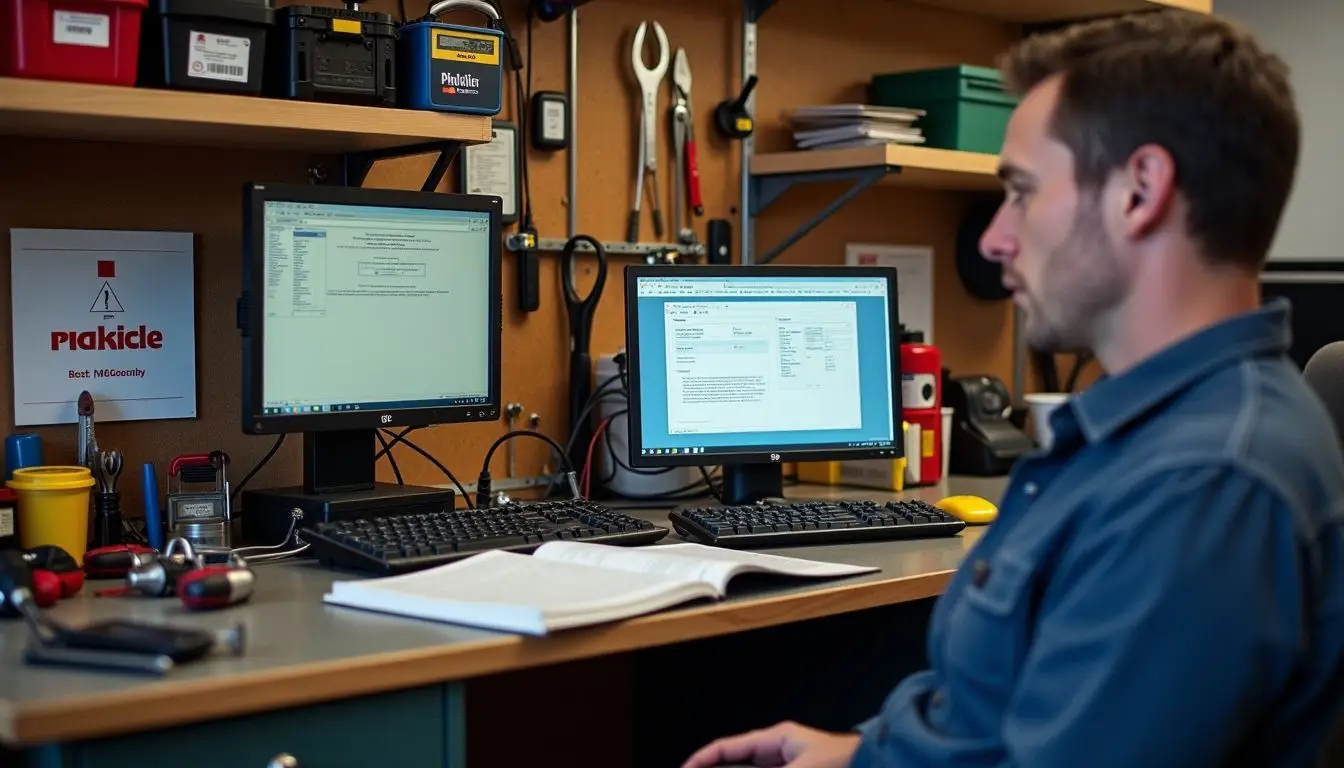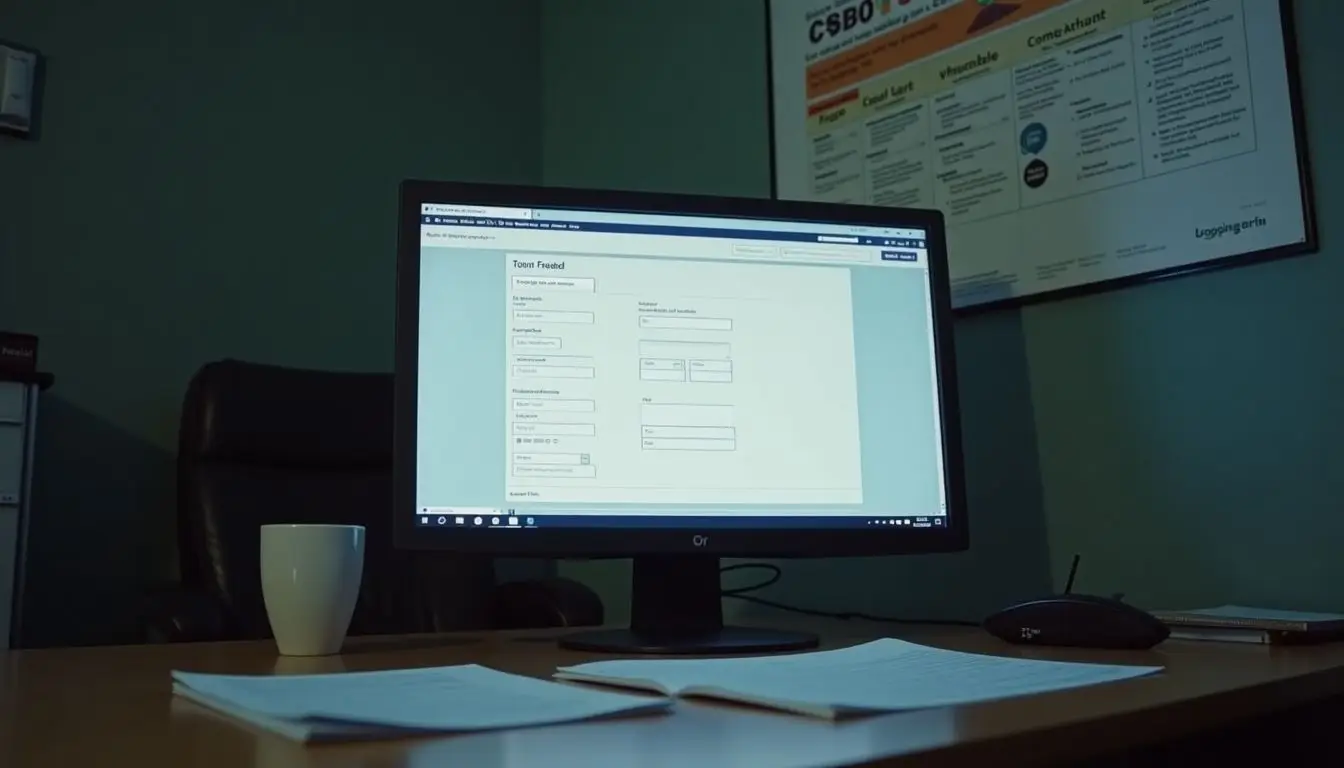Many companies face challenges with keeping their service operations running smoothly. One big problem is knowing how well technicians do their jobs out in the field. A key fact to know is that regular checks on how technicians work can make things way better for a business.
This blog will guide you through making the most of technician performance tracking to upgrade your service operations. We’ll talk about choosing the right tools, boosting efficiency, and making customers happier.
You’ll learn ways to use data and tech smartly for better results. Get ready for helpful tips!
Key Takeaways
- Tracking how well technicians do their jobs helps businesses work better. It saves time and money by cutting down on extra trips and material use.
- Using the right tools makes it easier to see where improvements can be made. Features like real-time tracking, data analysis, and mobile access are important.
- Happy customers often come from quick and good service. Good communication tools help keep customers informed about their service status.
- Training for technicians is key to doing a good job. When staff knows how to use new tech, they can solve problems faster.
- Gathering feedback from both teams and customers helps make services better. This information guides changes for improved efficiency and satisfaction.
Understanding Service Technician Tracking
![]()
Service technician tracking helps businesses monitor and manage their field staff. It improves efficiency and boosts customer satisfaction by keeping teams organized and informed.
Definition

Technician performance tracking measures how well field service technicians perform their jobs. It helps businesses see where improvement is needed. This process uses software to monitor key metrics such as productivity and efficiency.
Organizations can use this data to make informed decisions. Regular monitoring leads to operational improvements, cost savings, and increased customer satisfaction. By focusing on technician productivity, companies can reduce the number of return trips and save materials.
Benefits for field service businesses

Field service businesses gain many advantages from technician performance tracking. Regular monitoring of technician productivity leads to major operational improvements. For example, tracking data helps companies cut down on return trips and avoid redundant labor.
This means less wasted time and resources, resulting in cost savings.
Improving field technician productivity also reduces the mean time to resolution (MTTR). Faster service increases customer satisfaction in field service management. With real-time visibility, businesses can make better decisions about resource allocation.
Gathering key performance indicators allows teams to track trends effectively. Overall, these factors greatly enhance efficiency in field service operations.
Common features and tools
Service technician tracking software has many useful features. These tools help improve operational efficiency and boost technician performance.
- Real-Time Tracking: This feature allows managers to see where technicians are at all times. Real-time data helps reduce return trips and saves costs.
- Performance Monitoring: Tracking technician productivity is vital. Regular monitoring leads to better resource allocation and improved service delivery.
- Scheduling Tools: Efficient scheduling ensures technicians reach jobs on time. Optimizing routes cuts down travel time, which reduces mean time to resolution (MTTR).
- Data Analytics: Analyzing key performance indicators helps identify trends. Organizations can use data insights to make informed decisions about staffing and training.
- Communication Features: Good communication tools allow for quick updates between the office and field workers. Enhanced customer communication improves satisfaction levels significantly.
- Job Progress Tracking: This tool shows how much work is left on a task. Job progress tracking increases accountability among technicians.
- Mobile Access: Technicians need access to important information on the go. Mobile apps keep them connected with real-time updates, leading to better service quality.
- Inventory Management: Tools that manage inventory help reduce material waste during jobs. Proper tracking minimizes excessive resource use, leading to cost savings.
- Training Modules: Modern training solutions support continuous learning for technicians. Well-trained staff are more efficient in their work, which enhances overall productivity.
- Customer Feedback Systems: Collecting feedback from clients helps companies understand service quality better. This information is crucial for ongoing improvement in field service operations.
These features work together to enhance field service operations effectively while improving technician efficiency and customer satisfaction.
Choosing the Right Service Technician Tracking Solution
![]()
Choosing the right service technician tracking solution is key for success. Look for features that meet your needs and check reviews to find the best fit.
Factors to consider
Choosing the right service technician tracking solution is crucial for success. Several factors can help improve field service operations and drive better outcomes.
- Technology Needs
Select software that fits your business needs. Field service management software should offer features like tracking and reporting. Investing in technology can lead to big gains in technician performance monitoring. - User-Friendly Interface
A simple and user-friendly interface helps staff adapt quickly. Workers will spend less time learning how to use the system and more time on their tasks. Real-time visibility improves service delivery optimization. - Integration with Existing Systems
The new system should work well with your current tools. Ensure it integrates smoothly with other software you use. This keeps all data in one place, making decision-making easier. - Mobile Access
Technicians need access to information while on the go. A mobile-friendly platform allows them to check job details anytime, anywhere. This boosts efficiency by streamlining field service management. - Customization Options
Look for a solution that can be adjusted to fit your business model. Customizable features allow you to tailor the system according to your needs. - Data Security
Protecting sensitive data is vital for any organization. Confirm that the chosen software has strong security measures in place for safe information storage. - Customer Support Services
Good customer support is essential when using new software. Reliable support ensures quick assistance when issues arise, helping maintain operational effectiveness. - Monitoring Performance Metrics
Use performance monitoring tools within the system regularly, as significant improvements come from analyzing technician productivity closely as stated in important facts one and five. - Cost Considerations
Evaluate the cost against potential benefits carefully before making a decision about which option is best suited for your budget while maximizing technician efficiency improvement. - Feedback Gathering Capabilities
Feedback tools provide valuable insights from technicians and customers alike around fields service operations performance improvement, allowing adjustments based on real experiences and preferences.
Evaluating and comparing options
Evaluating and comparing different service technician tracking solutions requires attention to specific factors. These factors include the ability to monitor technician productivity, reduce mean time to resolution (MTTR), and enhance customer satisfaction. Here is how options can be compared:
| Feature | Importance | Example |
|---|---|---|
| Technician Productivity Monitoring | High | Tools that offer real-time tracking and productivity analytics |
| Reducing MTTR | High | Solutions that provide efficient job scheduling and dispatch |
| Customer Satisfaction | High | Platforms that enable direct communication between technicians and customers |
| Cost Savings | Medium | Systems that minimize return trips and excess material use |
| Compliance and Safety | Medium | Software that ensures field service operations meet safety standards |
| Data Management and Automation | Medium | Applications that automate data entry and report generation |
Investing in technology that offers comprehensive monitoring of technician activities leads to operational improvements. Field service organizations see cost savings by avoiding unnecessary visits and usage of materials. They also experience a decrease in MTTR, enhancing overall efficiency. Customer satisfaction improves with the implementation of job progress tracking. Service operations benefit from modernized training and optimized service call planning. Real-time visibility into field service management is crucial. This visibility comes from data that informs resource allocation and operational decisions. Field service metrics become actionable through technology investments, proper staff training, and defined objectives. Continuous improvement in service operations is achieved by embracing mobile technology, standardizing processes, and focusing on preventive maintenance.
Case studies and reviews
Case studies and reviews show how tracking technician performance can boost field service operations. Field service organizations that monitor technician productivity often see big improvements.
For example, many have cut costs by reducing return trips and unnecessary labor. This data helps managers make smarter decisions.
Real-time visibility also improves customer satisfaction in field service management. Many companies report happier customers after they implemented job progress tracking. These businesses gained valuable insights into technician efficiency and equipment use, which helped them serve clients better.
Improving Efficiency and Customer Satisfaction

Real-time tracking helps teams work better and keep customers happy. Quick communication boosts trust between technicians and clients. Using automation saves time on routine tasks.
This leads to faster service and more satisfied customers. Want to learn more about these benefits? Keep reading!
Real-time tracking and communication
Tracking technicians in real-time boosts communication and efficiency. Organizations can gain clear visibility into field operations. This helps to monitor key performance indicators closely.
By using data effectively, businesses can identify trends and make smart choices.
Improving service call planning leads to faster job completion. Less time on the road means cost savings for companies. It reduces return trips and wasted materials, which lowers expenses overall.
Increased customer satisfaction often follows efficient service management as clients appreciate timely updates. Companies unlock valuable data that guides technician management and improves productivity in the field service operations process.
Automation and data management
Automation boosts service operations. It makes tasks easier and faster. Companies can save time and money with smart tools. By automating processes, they cut down on return trips, extra labor, and wasted materials.
This leads to cost savings.
Data management is key for field service businesses. Organizations can track technician productivity through data analysis. Monitoring metrics helps in making better decisions. With real-time tracking, teams can see how jobs progress.
This visibility increases customer satisfaction and improves efficiency in field service operations.
Enhanced customer communication and satisfaction
Enhanced customer communication leads to greater satisfaction. Real-time tracking and data help field service organizations respond quickly to customer needs. This quick response makes customers feel valued.
Monitoring technician performance allows for better planning of service calls, which reduces delays.
Increased efficiency also boosts customer happiness. Field service teams can solve problems faster with improved communication tools. Tracking job progress keeps customers informed about their service status.
Happy customers often become loyal ones, leading to positive reviews and referrals for the business.
Improved safety and compliance
Tracking technician performance improves safety and compliance in field service operations. Regular monitoring helps organizations follow industry rules and standards. This reduces risks on the job site and promotes a safer work environment for technicians.
By analyzing data, businesses can spot areas needing improvement. They can then provide training to enhance skills and ensure workers adhere to safety protocols. Better safety measures lead to fewer accidents and injuries, boosting overall productivity.
Improved safety also raises customer satisfaction since they trust that services meet high standards.
How to Make Field Service Metrics Actionable

To make field service metrics useful, you need to invest in the right technology. Train your staff and set clear goals to improve results.
Investing in technology
Investing in technology can greatly improve service operations. Regular monitoring and analysis of technician productivity leads to big gains. It helps reduce costs by cutting return trips, extra labor, and wasted materials.
By maximizing technician productivity, organizations can lower mean time to resolution (MTTR).
Using data allows firms to track key performance indicators easily. With real-time visibility, field managers make smarter decisions about resource allocation. Improving service call planning also boosts efficiency for technicians on the job.
Embracing these tools enhances customer satisfaction and overall operations in the field service industry.
Training staff
Training staff is crucial for enhancing field service operations. Modernizing technician training leads to better efficiency. Skilled technicians can solve problems faster, reducing the mean time to resolution (MTTR).
With effective training, staff becomes familiar with new tools and techniques. This boosts overall productivity.
Regular monitoring of technician performance helps identify areas for improvement. By focusing on continuous learning, companies can drive better results. Investing in technology supports this effort by providing data that guides decisions.
Overall, well-trained staff improves customer satisfaction and benefits the entire organization.
Defining clear objectives
Clear objectives help measure technician productivity effectively. They guide technicians in their daily tasks. Defining these goals can lead to significant operational improvements.
By tracking key performance indicators, field service organizations can monitor trends and make informed decisions.
Setting clear targets also helps optimize scheduling and preventive maintenance efforts. Efficient planning cuts down on return trips, reducing costs for businesses. Lengthy mean time to resolution (MTTR) decreases as technicians focus on specific goals.
This approach enhances overall customer satisfaction by providing timely services and better communication.
Optimizing scheduling
Optimizing scheduling can greatly enhance service operations. It helps in managing technicians’ time and routes more effectively. This leads to fewer return trips and less wasted labor.
By improving scheduling, organizations can cut costs significantly as a result.
Field service organizations that track technician performance see better resource allocation. Real-time tracking shows where help is needed most. It also reduces the mean time to resolution (MTTR).
With efficient scheduling, businesses boost productivity while keeping customers happier.
Focusing on preventive maintenance
Preventive maintenance is crucial for improving service operations. It helps reduce sudden equipment failures. This leads to fewer emergency repairs and lower costs. Regular check-ups can minimize return trips by technicians.
They won’t need to come back as often, saving time and material use.
Measuring technician productivity through preventive maintenance boosts efficiency. Field service organizations can see clear benefits when they focus on this area. Strategies like having a schedule for maintenance checks can optimize the workflow of technicians.
Happy customers are more likely when services run smoothly, leading to increased satisfaction in field service management.
Continuously Improving Service Operations

To improve service operations, gather feedback from your team and customers. Use this information to adjust your processes and meet their needs better.
Gathering feedback
Gathering feedback is key for improving field service operations. Regularly collecting input from customers and technicians helps organizations understand what works and what doesn’t.
This feedback can highlight areas needing attention or change.
Monitoring technician performance leads to better resource allocation. When companies analyze this data, they gain insights into productivity levels. These insights help improve decision-making in field service operations, which enhances customer satisfaction and boosts technician productivity.
Embracing mobile workforce
Embracing a mobile workforce can greatly improve service operations. Real-time visibility helps in efficient field service management. Technicians equipped with mobile tools can quickly access important data.
This leads to better decision-making and resource allocation.
Regular monitoring of technician productivity drives operational improvements. Tracking their performance allows businesses to find areas needing change. Improved training and knowledge sharing from experts enhance technician efficiency.
Organizations that focus on these aspects see cost savings and quicker resolutions for customers.
Standardizing processes
Standardizing processes helps field service operations run smoothly. By having clear steps, technicians know what to do. This reduces mistakes and saves time. Regular monitoring of technician productivity leads to big gains in efficiency.
It can also cut costs by minimizing extra trips and unnecessary work.
Improved training for technicians is part of standardization. This sharing of expert knowledge boosts confident performance on the job. Better planning of service calls brings real-time visibility into tasks too.
When these elements come together, organizations can improve customer satisfaction while enhancing service operations tracking and decision-making efficiently.
Implementing preventative maintenance
Implementing preventative maintenance helps field service organizations save money. Regular checks can reduce return trips and extra material use. Better planning lowers costs by cutting down on redundant labor.
Monitoring equipment before issues arise leads to higher technician productivity. This practice also shortens mean time to resolution (MTTR). By focusing on these strategies, businesses can improve service operations performance too.
Personalizing service for customers
Personalizing service for customers can greatly improve satisfaction. Field service organizations can use data to understand customer needs better. Regular monitoring of technician performance helps allocate resources wisely.
This leads to quicker resolutions and fewer return trips, saving costs. Enhancing communications with customers boosts their experience as well.
Improving technician training also plays a role in personalizing services. Skilled technicians can address unique issues more effectively. Tailored solutions lead to happier customers and increased loyalty.
By focusing on individual preferences, businesses enhance overall field service operations performance improvement.
Conclusion

Tracking technician performance can greatly improve service operations. Regular checks lead to better productivity and cost savings. These strategies are straightforward and easy to use.
Think about how you can apply them in your own work. Enhancing your service process may boost customer satisfaction and efficiency. Explore more resources to learn how data can help you succeed.
Take action today, and watch your operations thrive!
FAQs
1. What does “Enhancing Service Operations: Harnessing the Power of Technician Performance Tracking” mean?
It refers to improving service operations by using technician performance tracking. This process involves measuring technician productivity, optimizing field service operations and workforce for better decision-making.
2. How can technician performance tracking enhance service operations?
Technician performance tracking can provide data that is crucial in process optimization in field service operations. It allows managers to measure productivity, identify areas for improvement, and make informed decisions.
3. Why is it important to measure technician productivity?
Measuring technician productivity helps in workforce optimization. It provides insights into how well technicians are performing their tasks, which can be used to improve training programs and increase efficiency.
4. Can harnessing the power of technician performance tracking lead to better decision-making?
Yes! By accurately measuring technician productivity and optimizing processes based on this data, businesses can make more informed decisions about resource allocation, task scheduling, and overall operational strategies.




